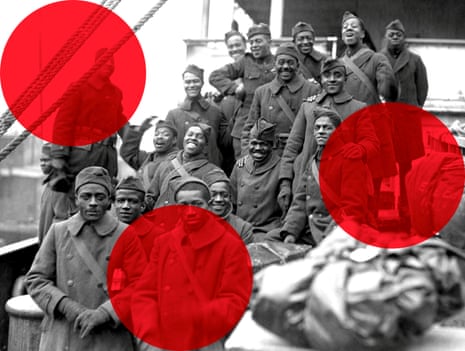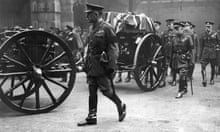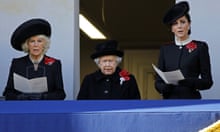Although the guns on the western front fell silent, literally with military precision, at the striking of the 11th hour on 11 November 1918, the end of war did not mark the coming of peace. The convulsions and instability that had been let loose upon the world continued to play out in ways that no armistice could prevent, and to ends that often suited the interests of the victors.
A century after the end of the first world war, few of those convulsions are well remembered in Britain. The centenary of the Russian revolution came and went without much fanfare, as will the anniversary of the German revolution. One of the many effects and after-effects of the first world war that have been forgotten is the way in which the war challenged the racial hierarchies of the early 20th century and how, in 1919 and the early 1920s, those hierarchies were violently reasserted. This is part of a wider amnesia.
In most of the nations who engaged in the conflict, the role played by the four million non-white non-Europeans who fought and laboured on the western front – and in other theatres of the war in Africa, the Middle East and Asia – has been airbrushed from popular memory.
This was the first truly global war. Mechanised industrial weapons, such as the machine gun, combined with modern railways to become the enabling factors that led to a war of siege and slaughter on a continental scale. In seeking to break the deadlock of the trenches, all the main combatant nations, in their different ways, attempted to globalise the war.
The British deployed the men of their Indian army on the European battlefield from October 1914; the decision being made within days of the outbreak of hostilities. They later called upon men from Africa and the West Indies and fielded armies of labourers from across the empire and from technically neutral China. The French filled their trenches with troops from their own colonies; the famous Senegalese Tirailleurs (infantry) from French West Africa, Spahi cavalrymen from North Africa and units from Vietnam and Madagascar.
Even Germany, although stripped of its colonies by 1915 and largely driven from the world’s oceans by the might of the Royal Navy, attempted to weaponise religion in order to fight a global conflict. Making common cause with the Ottoman Empire, Germany encouraged the Sultan to declare not just war but holy jihad against Britain, France and Russia. With varying degrees of success, this edict was then used by German agents to induce the leaders of other Muslim peoples, in Libya, Afghanistan and Sudan, to take up arms against the British and French.
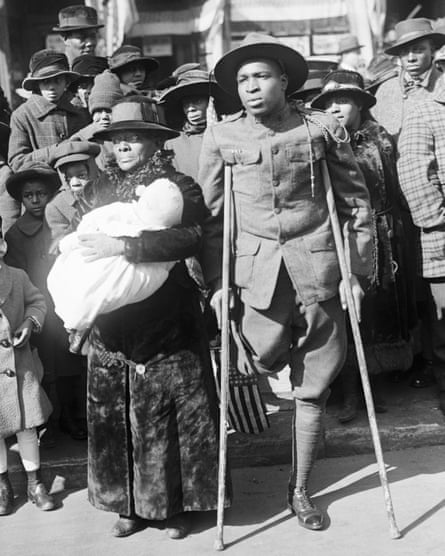
In the first weeks of the war the string of German victories in Belgium and on the French frontiers had encouraged the German state and the press to dismiss the presence of colonial troops as evidence of the British and French armies’ lack of fighting men; and as an exotic portent of impending German victory. When the victories stopped and the western front solidified in the last months of 1914, the German response changed radically. In 1915 the German government issued a formal condemnation of the deployment of non-white combatants. It was an appeal to white racial unity, one partially aimed at American public opinion. The German philosopher Max Weber spoke for himself and his nation when he angrily accused Britain and France of unleashing “a refuse of Africans and Asiatic savages”.
To help build its case, Germany also set about fabricating a series of atrocity stories; everything from supposedly barbarous Indian solders drinking the blood of slain Germans, to French West African troops carrying garlands of severed ears around their necks. Some German soldiers, men whose only contact with Africans had been in the infamous human zoos of the early 20th century, believed the propaganda and were astonished, on being captured by Africans, that their lives were spared and their status as prisoners of war recognised.
“To me”, wrote the American racial theorist Lothrop Stoddard, “the Great War was from the first the white civil war, which, whatever its outcome, must gravely complicate the course of racial relations.” Writing in the immediate postwar years, Stoddard – a Harvard graduate and “exalted cyclops” of the Massachusetts chapter of the Ku Klux Klan – believed that one of the most egregious consequences of the first world war had been a “frightful weakening of the white world”. This weakening, he warned readers of his 1921 book, The Rising Tide of Color Against White World-Supremacy, had “opened up revolutionary, even cataclysmic, possibilities”.
A “renascence of the brown and yellow peoples of Asia” that Stoddard believed had begun long before 1914 had been accelerated by the war. Races previously “kept within evolutionary bounds by the white world’s inherent strength and fundamental solidarity” had, he said, been partially unchained and now posed a threat to a world order founded upon white supremacy. For Stoddard, and the millions in the US and Europe who thought like him, the armistice of 1918 was not the blessed end of 52 months of mechanised bloodletting, but potentially the beginning of a new age of reckoning. All the combatant nations of 1914-18 had been guilty of the same crime; they had put guns into the hands of black and brown men and then commanded them to fight and to kill white men. Britain and France had made matters worse by forming alliances with Japan, a nation that Stoddard and many others had viewed with profound unease ever since the Japanese victory over Russia in the war of 1904-05 – “an event the momentous character of which is even now not fully appreciated,” Stoddard wrote.

Even if the first world war had been “a white man’s war”, race would nevertheless have been a factor. The war was of its time, an era in which social Darwinian concepts of racial purity and racial degeneracy were in the ascendancy. The belief that war itself was the purifying fire through which races passed in order to be tested and cleansed gripped the minds of many. Helmuth von Moltke, the chief of the German general staff, was highly influenced by social Darwinian notions of racial struggle, and others in the ruling elite shared his views. Many of those who came to view the conflict as a war of attrition had such concepts in the back of their mind.
Just as racial theory had inspired the outraged German denunciations of 1915, the recruitment of its enemies’ non-white legions had itself been informed by racial theory. The French recruited their armies in Africa in the belief that some of Africa’s ethnic groups, the Tukulor, Wolof, Serer and Bambara, were more naturally warlike than others. These people were les races guerrières, whom the infamous French general Charles Mangin would forge into his “force noire”.
So dedicated were the French to these theories that they convinced themselves that West Africans, being supposedly more primitive than Europeans, could better withstand the shock of battle and experienced physical pain less acutely. This justified deploying them as shock troops in the first line of battle. As a result, West African soldiers on the western front between 1917 and 1918 were two-and-a-half times more likely to be killed in action than white French infantrymen. The British held similar views of the people of India. Dismissing most of the people of the subcontinent as passive and effeminate, they only recruited from certain ethnic groups, the so-called “martial races”.
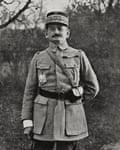
When the guns fell silent in 1918, both victors and vanquished turned against the black and brown men who had fought in what the victory medals then being struck for each allied soldier called “The Great War for Civilisation”. Among the forces sent to occupy the German Rhineland, under a clause of the armistice, were African American and French African troops. Whereas German complaints about the deployment of black soldiers in the trenches of the western front had largely failed to arouse international sympathy, now the war was over the propaganda campaign that was launched against the black soldiers of the army of occupation was a profound success, eliciting sympathy from the press and the trade union movement in Britain, and within sections of the public in the US.
In 1919 Germans on the socialist left and the nationalist right united to denounce the occupation as “die schwarze Schande” – the black shame. Unsubstantiated accusations were spread across the world that the French African troops were disproportionately guilty of violence and rape. German newspapers dehumanised the Africans, using the term “vertierte Neger” – “animal niggers” – and the artist Karl Götz struck a special medal depicting a German woman chained to a phallus, on which rested a French army helmet. Yet what enabled the German campaign against the black soldiers of the French army to become a global phenomenon was support and assistance from its former enemies.
The campaign’s greatest friend was the British journalist ED Morel, who had been one of the leaders of the “red rubber campaign” that exposed the genocide against the people of the Congo Free State perpetrated by the private army of the king of the Belgians, Leopold II. In 1920 Morel published a pamphlet, The Horror on the Rhine, in which he laid out in emphatic terms the racial neurosis that the war had exposed. “The militarised African, who has shot and bayoneted white men in Europe,” he claimed, “who has had sexual intercourse with white women in Europe, would lose his belief in white superiority.” An official investigation by the US army concluded that there was no evidence for the German claims and that the “black shame” campaign was merely an “adroit political move” to win sympathy and counter the wartime image of Germans as the “Hun”.
In the US, the same racial neurosis inspired Lothrop Stoddard’s fellow Klansmen to embark upon a wave of murder and intimidation designed to ensure that any hopes of racial justice nursed by the thousands of African American soldiers then returning from the western front were snuffed out. In 1919 at least 19 African American soldiers were lynched in the US, some for wearing their army uniforms in public, as they were perfectly entitled to do. In 26 American cities, black communities were attacked and people murdered in the streets, during the so-called and now forgotten “red summer”.
Similar events took place in Britain, and are just as lost to popular memory. There were nine so-called race riots across Britain in 1919. Black men who had worked on ships and in the factories, along with those who had fought for Britain at the front, were attacked by white mobs, and they and their families driven from their homes. In Liverpool, Charles Wooten, a sailor who had served Britain in the war, was killed by a mob in the Liverpool docks. His murder can only be described as a lynching.
A century on, if we as a nation are serious about remembrance, then the process of remembering must not come to an end this November. As well as remembering the service of the non-white soldiers and auxiliaries of the first world war, we have also to remember what happened to them and their dreams of justice in the months and years after the armistice.
